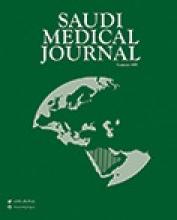Abstract
OBJECTIVE: The aim of this study is to determine the mode of presentation, medical and surgical treatment in diabetic foot.
METHODS: Medical notes of 34 diabetic patients admitted to King Abdulaziz University Hospital in Jeddah from June 1997 to June 1999 with diabetic foot were studied retrospectively. Collection of demographic data, mode of presentation, investigations, medical treatment (antibiotics cover) and surgical treatment has been studied. Data of those patients were collected for gender, age, duration of diabetes, mode of presentation, presence of peripheral neuropathy, peripheral vascular disease and other complications, precipitating factors, concurrent medical illness (ischemic heart disease, hypertension, chronic renal failure, and retinopathy), microbial flora, medical treatment by antibiotics, surgical treatment, and duration of hospital stay.
RESULTS: Majority of patients were male above 50 years, mean age 59 +\- 9.6, 29 male, 47% Saudi, 65% diabetic patients, their blood sugar were controlled by oral hypoglycemic drugs. However only 29% were on insulin. History of trauma preceding infection was present in 20%. Peripheral neuropathy was the main precipitating factor in 94%, as well the presence of peripheral vascular disease in 50%. Smoking was found in 44% patients. Foot ulcer was the most common type of presentation in 59% of patients, 65% of these patients need deberidement. However 8 patients had major amputation. Proteus and pseudomonas were the most common organisms isolated. The mean hospital stay was 21.44 +\- 17.7 days.
CONCLUSION: Diabetic foot sepsis is a common health problem presented in Saudi Arabia particularly among men, peripheral neuropathy, as well poor glycemic control are the most common precipitating factors. Foot infection is usually poly-microbial. Most of these patients required deberidement, however 8 (23.5%) of them, ended up having major limb amputation.
- Copyright: © Saudi Medical Journal
This is an open-access article distributed under the terms of the Creative Commons Attribution-Noncommercial-Share Alike 3.0 Unported, which permits unrestricted use, distribution, and reproduction in any medium, provided the original work is properly cited.






